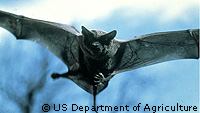Bats critical in transmission of Ebola
Researchers from the Institut de Recherche pour le Développement (IRD) in Paris (IRD) have identified a carrier for the Ebola (haemorrhagic fever) virus - bats. The Ebola virus has attained mythical status because of the high rate of infection and speed of fatality. Two species were identified in 1976: Zaire ebolavirus and Sudan ebolavirus with case fatality rates of 83 per cent and 54 per cent respectively. A third virus, Reston ebolavirus was discovered in a group of monkeys in 1989 and a single case of Ivory Coast ebolavirus was discovered in 1994. Outbreaks have hit Uganda, Gabon, Sudan and Democratic Republic of Congo - the latter as recently as May 2005. Transmission to humans was thought to occur through direct contact with infected primate carcasses, but the new research shows that transmission is possible through three species of bat. The team looked for healthy small bats in the areas surrounding infected primate carcasses. Once captured, the team subjected the animals to a range of tests to see if they carried the antibodies for the Ebola virus. Three species of bat - Hypsignasthus monstrosus, Epomops franqueti and Myonycteris torquata were found to carry the Ebola antibodies, indicating that they can carry the disease without developing the illness. Rates of infection rise in the dry season, when the team believes that bats and primates compete for the same food. The dry season is when bats give birth, and this may alter their immune responses, so when primates come into contact with placental fluids or blood from the bats, transmission of the virus may occur, though further research is needed to confirm this theory. Some bats are also occasionally eaten by the local human communities in epidemic-prone areas, so the team argues that a campaign of education and food aid is needed during the dry season to minimise such contact.
Countries
Congo, Côte d’Ivoire, France, Gabon, Sudan, Uganda



